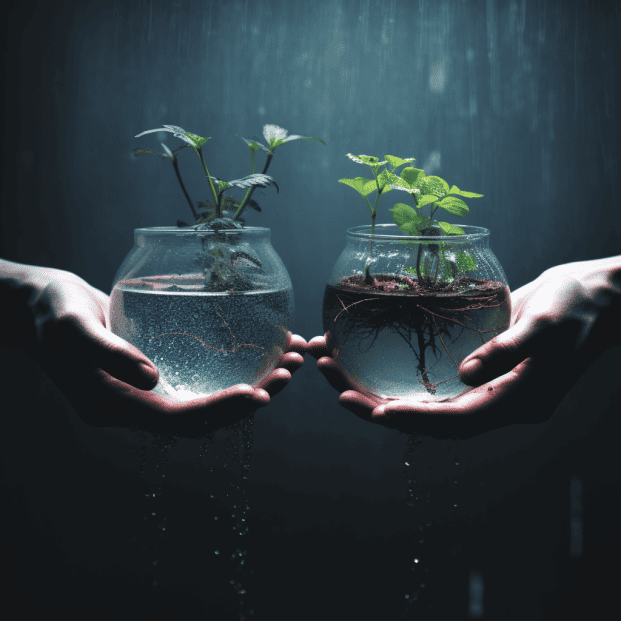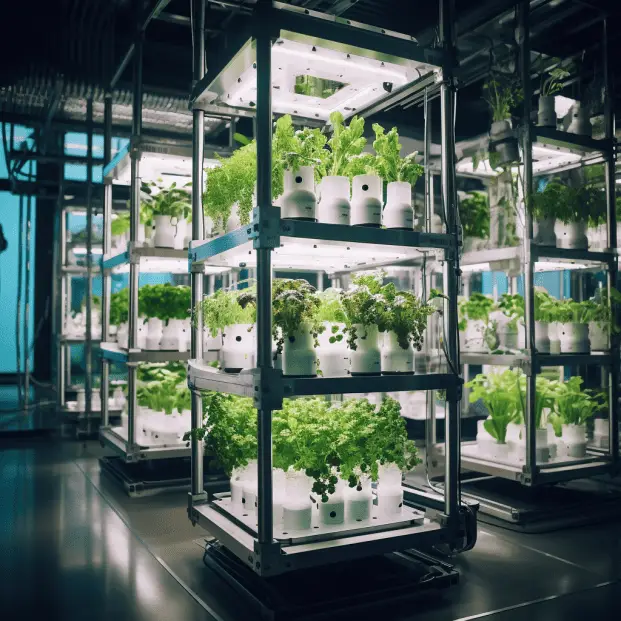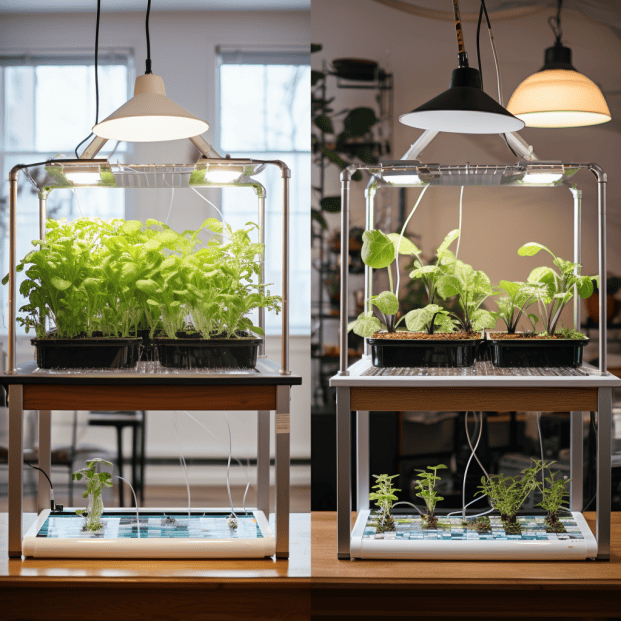Well folks, the topic of semi-hydroponics vs full-fledged hydroponics has certainly got indoor gardeners split down the middle like a wishy-washy politician.
On one hand, you’ve got the set-it-and-forget non-soil ways of hydro that promise plants galore.
But on the other sits semi-hydro – is it really hydro if your plants got their feet loose in the dirt?
As the neighborhood funny farmer, let me settle this debate once and for all with a hearty hogwash to all the hoo-ha!
Now before you go running home to pot up your entire veggie patch willy-nilly in water, hear me out – there’s more to these methods than meets the eye of your average green-thumb.
Take my cousin Clem for instance.
Why did his hydroponic tomatoes get dumped by his wife Sally last Tuesday? Because they were too top-heavy of course!
And what did the lettuce say to the cucumber? Nice growing with you!
I’ve got a smidgen more plant jokes to lighten the load, but I reckon we’ve yammered on enough.
The facts are, hydroponics and semi-hydroponics each have their own pluses to consider before switching your setup.
Done right, either can produce mighty fine rewards.
But toss out tradition too quick and you may find more floods than fodder on your hands.
So stick around, and I’ll spill the dirt on what really separates these methods at the roots.
By the end, you’ll be gleaning secrets from top growers on the easiest path to phenom crops.
Your plants will be thanking me later, I can promise you that!
Now for a faster harvest or an easier entry to aquaponics, keep on reading to get the straight scoop on each method’s pros and cons.
I’ll tell you everything a new indoor farmer needs to know before making the switch to water or a mix of mud.
Your next crop is depending on it, so pull up a chair – this thoughtful farmer is about to change the way you view plant raising for good!
KEY TAKEAWAY
Semi hydroponics vs hydroponics, which is better?
Semi hydroponics (1) combines aspects of traditional soil gardening with hydroponics, offering a middle ground that retains some benefits of both methods.
Fully hydroponic systems focus on water-based growth for efficient nutrient delivery and plant growth.
Comparing Methods: Semi Hydroponics vs Hydroponics
Whether using water or a mix of soil, indoor gardeners debate the merits of semi-hydroponics versus full hydroponics for good reason.
As an avid plant parent, I’ve tested both methods over many weeks to better understand each approach.
Now let’s compare key aspects to help you select the best fit for your green thumb.
A defining difference lies in the medium.
Hydroponics sustains roots fully in water without soil’s support.
Clay pebbles, expanded shale or other inorganic materials provide structure while ensuring optimal oxygen levels prevent root rots.
However, such mediums require precise fertilizer solutions, pH monitoring, and other parameters for balanced growing.
Semi-hydroponics strikes a harmonious balance, using a soil or soil-like medium like sphagnum moss to trap water near roots.
This cushions seedlings and establishes plants before transferring them to a reservoir without soil.
Retaining some soil properties eases stress on tender roots, yet still allows automated irrigation versus hand-watering.
Mature plants then enjoy hydroponics’ streamlined care.
Another key difference lies in plant transfers.
Hydroponic systems (2) setups see roots directly introduced to nutrient dense water and an inorganic medium from the start.
This demands extra precaution to guard fragile early roots from shock.
By contrast, semi-hydro starts roots firmly ensconced in a moisture-retentive organic medium with holes for sufficient oxygen.
Any stress comes later and is less severe during the key establishment phase.
Convenience also varies by method.
Semi-hydroponics automation remains simpler than hydro setups, which require pumps and timers to circulate solutions.
But hydro growers gain hands-free gardening with cuttings or seedlings stimulated directly into optimized growing environments.
Fewer inputs also trim costs for hydro over time compared to soil’s fertilizers.
Overall both deliver amazing results when done right.
But beginners or hobbyists seeking easy starts with minimal equipment will find semi-hydroponics the gentler entry.
More seasoned DIYers aiming to maximize space and yields with streamlined care lean toward total hydroponics and it’s high-function workflows.
With diligent care, thriving crops arise from waters or mixes there too.
Ease and Convenience: Hydroponics vs Semi Hydroponics

The best indoor gardening method balances superb results with simple upkeep – a key reason debaters ponder hydroponics versus semi-hydroponics.
As an avid plant parent, convenience ranks high on my list, so I aim to better understand where each excels on the ease scale.
Here’s a farmer’s-eye view of the labor levels involved.
For set-up, semi-hydroponics requires minimal materials – just some moisture-retentive medium like coconut coir, a saucer or tray, and a water reservoir below.
No pumps, tubes or electricals needed.
However, hand watering young plants remains.
Hydroponics setup demands plumbing materials yet automates irrigation entirely once running.
So hydro takes more work upfront but less ongoing attention.
Maintenance also differs.
Semi-hydro keeps medium constantly moist without flooding, requiring infrequent checking versus hydro’s fixed schedules.
But hydro’s closed-loop systems purge sediment automatically, where semi-hydro media like coir degrade faster, needing occasional refresh.
pH drift also impacts hydro more, demanding monitoring hydro’s mineral-rich solutions.
Cleanup for each stays simple with targeted protocols.
Flushing hydroponic systems keeps algae away, while pot-grown semi-hydro just swaps depleted media.
Good practices prevent bigger issues for both down the line.
Overall, hobby gardeners seeking effortless entry or busy schedules find semi-hydro easier initially.
But experienced indoor farmers targeting hands-off care or those crunched for space make hydro the superior set-it-and-forget option long run.
Whichever you choose, following each method’s routines ensures smooth, low-maintenance plant parenting.
Growth Performance: Semi Hydroponics vs Hydroponics

For avid indoor plant parents, maximizing crop yields remains top priority.
As an experienced gardener, I’ve grown several varieties of herbs, greens and flowers via semi-hydroponics and hydroponics to compare results.
While both excel, each offers a subtle edge in productivity that benefits certain plant types.
Through diligent testing over many harvest cycles, I’ve witnessed hydroponics stimulation remarkableroot growth and productivity for most fast-growing, high-water plants.
Without soil restricting space, impressive plant roots stretch far throughout clay balls or pebbles, fully utilizing the expansive inorganic medium.
Ivy-like roots form dense mats absorbing every drop of the mineral-rich nutrient water.
However, some ornamentals and finicky seedlings thrive better initially in the stability and moisture buffer of semi-hydro media like coconut coir.
The richness of these organic starting environments supports intricate root hairs and branching so critical in early days.
Hardier plant seedlings also stabilize faster transplanted semi-hydro medium and all into hydroponic systems once established.
Plants grown passively in semi-hydro systems via simple wicking action remain low fuss while meeting their needs.
So long as the moisture-dense media contacts the nutrient solution reservoir below, absorption occurs without pumps.
This hands-off workflow suits homesteaders or busy indoor farmers.
Overall, fast-growing annual plants and dripping wet crops perform phenomenally in fully-hydroponic systems.
But for precious orchids, bonsai and other slow starting plants, semi-hydroponics gentler nurturing during crucial seedling and propagation phases gains their highest rewards thanks to a living semi hydroponics medium.
Whichever method, following best practices reaps huge payoffs for any plant parent.
With diligent care, thriving crops arise from waters or mixes there too!
Advantages of Semi Hydroponics
Whether just dipping toes or fully immersed, both hydroponics techniques bring bounty to indoor gardens.
However, some intrinsic benefits make semi-hydroponics excel for certain varieties or situations.
As an avid plant parent, here are advantages I’ve witnessed firsthand:
Root development thrives thanks to the complexity and richness of organic semi hydroponic mediums like coir or sphagnum moss.
Their texture and chemistry nourish intricate early root hairs better than inert materials.
This supports stronger, healthier root structures from seedling stages onward.
Stress reduction also proves key.
Seedlings and clones establish more gently within a moisture-retentive medium stable against fluctuations.
Their roots acclimate to an aquatic environment gradually as the starting medium drains into water reservoirs.
Flexibility allows using whatever pots, tray or container style.
No specialized hydroponic parts needed – just a container holding medium with drainage holes above water level.
Adjusting the water gauge regulates moisture precisely for plants.
Cost remains low since no pumps, timers or other hardware required.
Just a container, growing medium, and nutrient-rich water provides everything needed for incredible growth.
Overall, semi-hydroponics brings hydroponics successes within reach of casual indoor gardeners or those new to aquatic cultivation techniques.
Its potent advantages make this hybrid approach an excellent entry point or complementary style wherever maximum root development ranks high.
Getting Started: Hydroponics and Semi-Hydroponics
Whether just entering indoor gardening or expanding horizons, successfully starting your first semi-hydroponic or hydroponic system remains key.
As an avid plant parent, focusing on proper materials, basic care needs and foundational principles sets any new grower up for thriving harvests to come.
With semi-hydroponics, all that’s required includes a preferred nursery pot for your plant, and that pot inserted within a slightly larger outer cache pot without drainage holes.
The assembly acts as a self-contained unit.
Fill the outer pot with clean water and your inner nursery pot will wick moisture from below through the well-hydrated growing medium like coconut coir or sphagnum moss.
No need for expensive air pumps or plumbing.
For hydroponics, the essentials involve a growing medium like expanded clay pellets within a net pot, reservoir or tray.
First, thoroughly soak new mediums before use to prevent them from wicking essential nutrients from young roots.
Then securely place seeded net pots above sterilized nutrient solution which flooded reservoirs or DWC buckets provide.
Regularly monitor and top off water levels to the required depth.
When starting cuttings or clones, distilled water alone suffices at first while roots establish.
Once developed, transition rooted cuttings or seedlings to full hydroponic nutrient formulations appropriate for their growing stage.
Always dilute concentrated nutrients to the recommended strength and take time acclimating plants to ensure healthy root growth without stress or risk of root rot.
Following foundational principles like keeping new transplants’ leaves moist but not saturated and providing optimal light, temperature and ventilation sets any system up for fast, strong plant roots whichever method is chosen.
Success lies in diligently meeting specific needs of whatever soilless method and species you select.
The rewards of bountiful harvests await!
Semi Hydroponics Characteristics
While similar to hydroponics, semi-hydroponics introduces key distinctions beneficial for home cultivators to understand.
As an avid indoor gardener, here are characteristics that make this hybrid technique an excellent option:
It provides stability to roots via an organic medium closely resembling soil’s properties.
This cushions new transplants, promotes intricate early root development, and sustains them as they acclimate to a hydrated environment.
The established root ball stays inserted within a preferred pot and medium rather than bare roots suspended in water.
This naturalizes the process versus a cold turkey transition to inert hydroponic materials.
Wicking draws up plain water from reservoirs, keeping medium optimally moist without risk of saturating delicate plant structures.
Automatic irrigation occurs without pumps or machinery.
Drainage holes allow any excess water to be reabsorbed by the medium rather than pooling.
Constant aeration prevents root rot issues associated with soggy potting mixes.
Nutrient acquisition benefits as roots uptake what they need from the hydrated growing medium and developing extensive structure.
Delicate species establishing cuttings prove especially appreciative.
Overall, through simple yet ingenious methods, semi-hydro harnesses hydroponics’ bountiful rewards while gentling plant parenting essentials for home cultivators.
Its low-stress techniques open a world of possibilities!
Weighing Options: Semi Hydroponics vs Hydroponics
When exploring soilless methods, weighing pros and cons helps fit choices to needs.
As an avid indoor farmer, experience growing through semi-hydroponics and hydroponics grants insight.
While each approach succeeds, match intention and skill to the appropriate style.
Semi hydroponics brings advantages like an organic medium closely mimicking potting soil’s properties.
Roots establish gradually into a hydrated setting via medium’s capillary ability rather than direct contact with water.
This cushions stress on plants shifted from soil.
Ease remains high with self-watering functions through passive uptake.
However, smaller plant root zones result compared to hydroponics’ freedom.
Growth stays limited by pot dimensions versus full hydroponics cultivated without constraints.
Senescing medium also demands periodic refresh versus inert materials’ longevity.
True hydroponics excels for maximizing space through expanded root volumes unbound by soil or containers.
Stirring occurs through growth within expanded clay or other porous yet inert mediums, supported by a constant supply of specially formulated nutrient liquid solution.
But machinery like pumps arterialize nutrients, increasing maintenance.
Risk also exists, as fluctuating flows or blockages halt oxygen and nutrient supply.
Lack causes rapid harm.
Careful protocols safeguard sensitive new roots among such exacting inputs.
Overall, semi hydro proves ideal for casual cultivators or plants of delicate _constitution.
Orchid growers_ and salable cut flower artists especially revere its gentleness.
But more hands-on hydroponics unlocks phenomenal crop production for serious indoor farmers.
Evaluating both assists fitting methods to desires.
Pros and Cons: Semi Hydroponics vs Hydroponics
Weighing advantages and limitations empowers selecting the best production method.
As an avid indoor gardener, here’s an objective breakdown of pros and cons exploring semi-hydroponics versus full hydroponics:
Semi-Hydroponics Pros:
- Natural, soil-like environment eases adapting from soil
- Cushions new transplants through passive, automatic hydration
- Low-cost, hands-off care requires no equipment
- Flexible for any container through wicking from water reservoirs
Semi-Hydroponics Cons:
- Confined root growth limited by pot size
- Frequent medium replacement as it breaks down over months
- Riskier for very young seedlings versus hydro’s buffered start
Hydroponics Pros:
- Maximizes yields with unconstrained root spread throughout medium
- Automated feeding on plants’ schedules prevents nutrient deficits
- Customizable for any crop through precise variable control
Hydroponics Cons:
- Steep learning curve to balance all inputs (pH, Electricity, etc.)
- Upfront costs of pumps, timers, tubing, and reservoirs
- Requires diligent maintaining to prevent fast problems
Overall, weighing specifics assists deciding whether soilless simplicity or yield maximization suits goals and skill best.
With any method, maintaining sterility prevents pests for happy, productive harvests.
Ever wondered if you can transplant your hydroponic plants to soil? Read out for more tips.
Conclusion
Well friends, I hope all that planty pondering has your greenhouses greener and your gardens bursting at the seams with ways to step up your crop game!
Whether semi-hydro or hydro is best for your space and needs, the key is finding balance between medium and moisture that makes your Plot Blossom.
Keeping things light but rooted or diving right into the deep end – both have reason in season, when rules are followed with care.
Trial and witness is key to your unique victor, so go try techniques to better pick your fit.
Data drag your dirtless drive or ease into aquatic arts – observe and tweak till success sings its song.
Now you’re armed with farmer knowledge, no excuse leaves yields you loathe! So get growing what floats your boat indoors.
Your plants and I will cheer your new efforts on.
Try techniques you’ve read of and share feedback, have questions don’t hesitate to ask.
Grow community welcomes collaboration, together our green dreams grow sky high.
Till soils once more may our chatters sprout more plant passion and full, happy harvests for all!
If you want to know whether it is possible to switch from soil to hydroponics, check out the article.
References
- https://www.plantclub.io/blog-en/substrate-semi-hydroponics#:~:text=Semi%2Dhydroponics%2C%20not%20to%20be,as%20sustainability%20and%20pest%20prevention.
- https://www.nal.usda.gov/farms-and-agricultural-production-systems/hydroponics#:~:text=Hydroponics%20is%20the%20technique%20of,%2C%20hobbyists%2C%20and%20commercial%20enterprises.
Related Articles
- https://tophydroponicgarden.com/can-you-switch-from-soil-to-hydroponics/
- https://tophydroponicgarden.com/can-you-go-from-hydroponics-to-soil/
- https://tophydroponicgarden.com/hydroponics-introduction/
Was this helpful?

Crystal Erickson is an agriculture enthusiast and writer with a passion for sustainable farming practices and community development. Growing up on a family farm in rural Iowa, Crystal developed a love for the land and a deep appreciation for the hard work and dedication required to make a farm successful.
After completing a degree in Agriculture and Environmental Science from Iowa State University, Crystal began her career as an agricultural journalist, covering stories and issues related to modern farming practices, crop management, and livestock production. She quickly established herself as a respected voice in the industry, known for her insightful reporting and thoughtful analysis.
Over the years, Crystal has written for a variety of publications, including Farm Journal, Successful Farming, and Modern Farmer, as well as contributing to several academic journals focused on sustainable agriculture and community development. Her work has been recognized with numerous awards, including the Iowa Farm Bureau’s Young Farmer Achievement Award and the National Association of Farm Broadcasting’s Farm Broadcaster of the Year.


